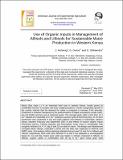| dc.description.abstract | Maize (Zea mays L.) is an important food crop in western Kenya, mostly grown by smallholder farmers in complex and risky cropping systems. Trends in population growth in the country indicate that the demand for maize is projected to increase 3-4% annually. Production is however hampered by the predominance of fragile ecosystems (acidic soils), low soil fertility and low use of chemical inputs. The average grain yield is less than 1.0 t ha-1 instead of a reachable 5.0 t ha-1, leading to vicious cycle of food insecurity. An on-farm experiment was conducted in two soil types (Alfisols and Ultisols) in Kakamega, western Kenya, between February and September 2007 to test effects of various organic inputs (Farmyard manure, Tithonia biomass and Desmodium cover crop) in combination with inorganic fertilizers (N, P, K, Mg, B and Zn) on yield of maize. The design was Randomized Complete Block Design, replicated 5 times and the data was subjected to ANOVA and DMRT tests. Soil analysis before planting indicated that pH was 5.0 and 5.4 in Alfisols and Ultisols, respectively. Both soils were deficient in N and P but adequate in exchangeable bases (K, Ca and Mg). Maize grain yield was higher in Ultisols compared to Alfisols. In Alfisols, organic inputs in combination with 30 kg N ha-1 gave maize grain yield improvement of nearly 100% over farmer’s practice (non improved maize variety, wider plant spacing, inorganic fertilizer applied at the rate of 20 N + 20 P ha-1, one weeding). When inorganic fertilizer (60 kg N + 60 kg P ha-1) was applied to maize/banana intercrop, maize yield increased by about 40%. In contrast, in Ultisols, organic inputs increased maize grain yield by between 85% and 115%, while maize/banana intercrop (plus 60 kg N + 60 kg P ha-1) increased maize grain yield by only 4% over the farmer’s practice. Banana intercrop reduced maize population resulting in low maize grain and stover yield. Use of either farmyard manure, tithonia biomass or desmonium cover crop in combination with 30 kg of N ha-1 (from inorganic source) can enhance maize production among smallholder farmers in acidic soils who ordinarily cannot afford to purchase adequate quantities of inorganic fertilizers | en_US |

